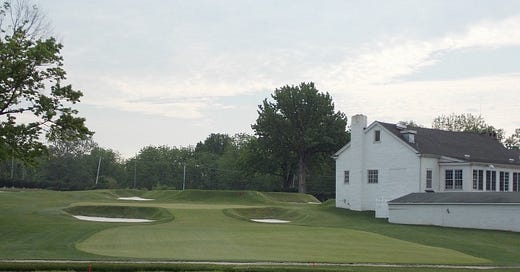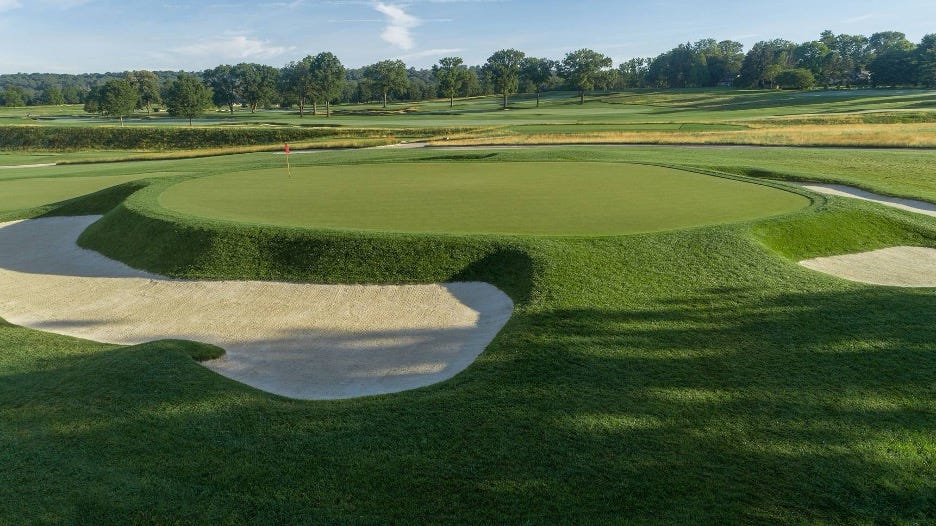Modern Golf Equipment and Golden Age Design
The PGA Tour is making a stop this week at Philadelphia Cricket Club for the Truist Championship. Philadelphia Cricket Club claims to be the oldest country club in the United States. Established in 1854, Philadelphia Cricket Club includes 3 courses, notably the Wissahickon course designed by A.W. Tillinghast, opening in 1922 and placing it squarely in the camp of “golden-age architecture”.
Photo Credit: Golf with Phil Sokol
Like most golden-age courses, the Wissahickon course is nestled in among natural landforms and was designed with strategic nuance and shot variety in mind. While emphasis on angles and risk-reward choices may still influence the average golfer, today’s tour pros easily negate and diminish these design considerations, clearing hazards and overpowering the design with a mind-numbing driver-wedge strategy.
While renovated in 2014, the championship tees listed on the scorecard of Wissahickon play to 7,119 yards. For the everyday golfer, 7,000 plus yards plays long. Unfortunately, for the modern-day tour pro with club and ball advances, this is relatively short by modern day Tour standards.
Technological enhancements have boosted the capabilities of the modern professional. Driver heads with ever-increasing head sizes, increased moment of inertia (MOI), and optimized aerodynamics, multi-layered golf balls with special spin coatings that result in low-spin with driver and high-spin with irons, launch monitors that optimize swing and launch conditions. All of these things have allowed professionals to hit the ball further and minimize the effect of poor strikes. The first-round scores at the Truist illustrate this point well. Keith Mithcell finished the first round leading the pack at 9 under par, while Michael Kim finished in last place at 2 over par.
Granted, all players professional and amateur alike can realize benefits from this technology. Distance and dispersion are positively affected which makes the game less frustrating for the amateur. However, this technology in the hands of the modern day professional largely negates the design ethos that golden age courses present. The ability to carry bunkers and hazards that once required careful consideration, with less need to shape shots or strategize around terrain, has resulted in the loss of the strategic challenge, especially that presented by golden-age strategic design. Shorter approach shots can render complex greens moot. Cross-bunkers, doglegs, and fairway traps can be flown and bypassed. A higher emphasis placed on high-launching, higher-spin wedge shots negates shaped approaches.
Photo Credit: USGA
This results in a somewhat multi-faceted viewership problem for the PGA Tour. Dull, corporate, and bland modern courses that have been designed with length in mind can better challenge the modern professional. However, golden-age designs are largely left to the wayside in this approach, wrenching away from viewers the opportunity to watch the best players in the world take on the most famous (and exclusive) courses, lowering the draw for tournament viewership.
Overall, the harmony of golden age architecture, risk-reward decision making, and classic shot-making is broken by the power and scale provided by modern golf technology in the professional game. The question naturally arises: how to address this issue? Lengthening courses is not always feasible. Land constraints present a large hurdle to many courses. Additionally, the cost to add yardage can be a considerable investment just to host a PGA Tour tournament one weekend a year.
If we really want to test the professional tour player on venues viewers will actually find interesting, some combination of equipment rollback and bifurcation of the professional and amateur game is necessary. Professional players already use “tour-only” equipment. Reduction in driver-head size and/or rolling back the golf ball to some degree for professionals would result in shorter driving distance and greater penalties for less than perfect strikes. Bifurcating the professional and amateur games can fix the distance problem without affecting the amateur player and would allow golden-age golf courses to be relevant to the professional game again.






